Master Padmasambhava: Guru Rinpoche
Master Padmasambhava, also known as Guru Rinpoche or Lotus-Born Master, is a pivotal figure in Tibetan Buddhism. Born in the 8th century, he is celebrated as the founder of this spiritual tradition in Tibet. His journey from India to Tibet marked the beginning of a new era, where he established the first monastery on Tibetan soil. He played a crucial role in translating significant Buddhist texts into Tibetan, fostering a rich spiritual heritage that blends esoteric and exoteric teachings.
Padmasambhava is known by several esteemed titles, reflecting his profound influence and spiritual mastery. Devotees refer to him as the Great Master, Precious Guru, and the progenitor of the Nyingma school, among others. These titles honor his foundational role in Tibetan Buddhism and his revered status across various traditions.
The Birth of a Legend
According to historical texts, Padmasambhava was born miraculously in the kingdom of Uddiyana. His birth, marked by divine signs, occurred on the 10th day of the fifth lunar month, making it a day of great celebration in the Buddhist calendar. His arrival was prophesied to bring immense spiritual teachings to the world.

The Eight Manifestations of Padmasambhava
Padmasambhava is known for his eight manifestations, each representing different aspects of his teachings and spiritual accomplishments. These forms range from peaceful to wrathful, demonstrating his versatile methods for guiding beings towards enlightenment.
- Tsokyé Dorje(མཚོ་སྐྱེས་རྡོ་རྗེ་) symbolizes his divine origin, born from a lotus in a king’s quest for treasure.
- Dorje Drolo (རྡོ་རྗེ་གྲོ་ལོད་), showcases his wrathful aspect, subduing negative forces and guiding beings with potent spiritual methods.
- Shakya Senge (ཤཱཀྱ་སེང་གེ་), represents his role as a teacher, embodying the wisdom and compassion of Buddha.
- Loden Chokse (བློ་ལྡན་མཆོག་སྲེད་) highlights his mastery of both exoteric and esoteric teachings, possessing deep understanding and insight.
- Padmasambhava (པདྨ་འབྱུང་གནས་), himself, demonstrating miraculous powers to transform hostility into faith.
- Pema Gyalpo (པདྨ་རྒྱལ་པོ་), portrays him as a royal spiritual advisor, revered and honored by the kingdom.
- Nyima Oser(ཉི་མ་འོད་ཟེར་), illustrates his ability to perform miraculous feats and spread advanced tantric teachings.
- Senge Dradog (སེང་གེ་སྒྲ་སྒྲོག་), signifies his prowess in debate and spiritual conquest, defeating non-Buddhist scholars with his wisdom.
The Legacy of Padmasambhava
Padmasambhava’s life and teachings continue to inspire millions around the world. His role in establishing Buddhism in Tibet and his profound spiritual insights have made him a central figure in the hearts of practitioners. By embodying compassion, wisdom, and the power to transform adversity into the path of enlightenment, Padmasambhava remains a beacon of spiritual guidance and transformation.
The Life Story of Guru Padmasambhava
Early Buddhist Influences
Guru Padmasambhava, a significant figure in Tibetan Buddhism, has a remarkable origin story that intertwines the divine with the mortal. His grandparents, unable to conceive after their marriage, sought blessings from the masters and wise men of the Bon religion, offering gold powder carried by an elephant and reciting the compassionate Buddha’s sutras. Miraculously, a beam of light from the compassionate heart of Samantabhadra (Universal Worthy) Bodhisattva touched his grandmother, signifying her forthcoming pregnancy with an “A” syllable at the light’s end. This divine intervention led to the birth of Padmasambhava’s father, Zhanba Nanke, marked by auspicious signs like a golden lotus with a swastika on his chest and wisdom eye marks, symbolizing his divine origins and wisdom.
The Family of Padmasambhava
Zhanba Nanke, regarded as an incarnation of Manjushri (the Bodhisattva of Wisdom) and revered as the father of Vajrayana Buddhism, was born into a family with profound spiritual connections. His mother, a Brahmin girl and daughter of Samantabhadra, and his elder brother, born with great auspiciousness, further underline the extraordinary lineage from which Padmasambhava descends. Despite the spiritual stature of his family, Padmasambhava’s mother decided to leave her husband in pursuit of deeper spiritual realization, taking her youngest son with her on a journey that would shape the future of Buddhism.
Significant trials and spiritual quests marked Padmasambhava’s childhood. After separation from his biological parents, a king in South India discovered and raised him, which earned him the name “Lotus Born.” This crucial period in his life shaped his spiritual path, eventually leading him back to his birth mother. She then directed him to discover hidden treasures of Bon scriptures in a cave. These teachings would lay the foundation for his future contributions to Buddhism.
The Creation of the Nyingma School
Following his mother’s guidance, Padmasambhava sought out the Bon texts and mastered them, along with the teachings received from his father, Zhanba Nanke. His profound realization and mastery over spiritual practices led him to become a royal guru and eventually to the establishment of the Nyingma school of Tibetan Buddhism. Despite the potential risks of altering sacred teachings, Padmasambhava’s innovations and translations were instrumental in spreading Vajrayana Buddhism, underlining his role as a pivotal figure in its development.
Guru Padmasambhava’s life story, from miraculous birth to the establishment of the Nyingma school, underscores his monumental impact on Buddhism. His teachings, rooted in both Bon and Buddhist traditions, reflect a deep understanding of spiritual practices and a commitment to spreading enlightenment. Through his contributions, Padmasambhava remains a revered figure, symbolizing the integration of wisdom, compassion, and the power of transformation in the pursuit of spiritual awakening.
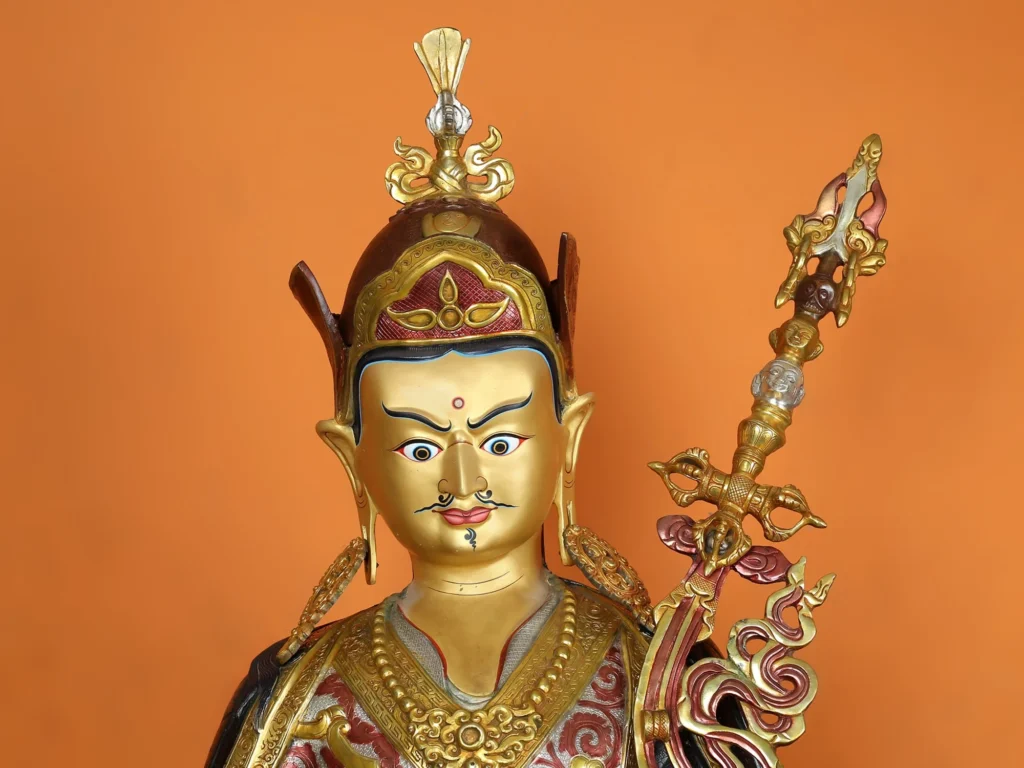
The Parinirvana of Guru Padmasambhava
According to the scriptures of his teachings, Guru Padmasambhava achieved Parinirvana, a state of final nirvana after death. His departure was not an end but a continuation of his commitment to subdue demons in the southwest. It was foretold that he would reincarnate in the southwest to fulfill this promise to his father, demonstrating his enduring dedication to protecting the Dharma and its practitioners.
A Mystical Figure in the History of Buddhism
Guru Padmasambhava is a legendary figure in the history of Buddhism, particularly during the early days of its introduction to Tibet from India. Living in the 8th century, he hailed from the kingdom of Uddiyana (present-day Pakistan). He was ordained in Bengal under the guidance of Master Prabhahasti, receiving the name Shakya Senge (Lion of the Shakyas), and studied numerous exoteric and esoteric texts under many great teachers.
His Spiritual Journey and Achievements
Padmasambhava practiced intensely in charnel grounds, known as places of powerful spiritual practices, where he attained various siddhis (spiritual powers) associated with Vajrayana Buddhism. His reputation for these accomplishments spread far and wide, leading to an invitation from King Trisong Detsen of Tibet to come and spread Buddhism. With the support of King Trisong Detsen, Guru Padmasambhava played a pivotal role in the propagation of Vajrayana Buddhism in Tibet. Alongside another great Indian master, Shantarakshita, they established the first Buddhist monastery in Tibet, Samye Monastery, which still stands as a testament to over twelve centuries of Tibetan Buddhism. This establishment marked the beginning of ordained Buddhist practitioners in Tibet.
His Legacy and the Nyingma School
Guru Padmasambhava’s efforts in subduing local spirits and laying the foundation for Buddhism’s growth in Tibet were monumental. He cultivated a generation of accomplished practitioners, including the king himself, among the twenty-five disciples who achieved great spiritual heights. Tibetan society venerates him alongside Trisong Detsen and Shantarakshita as one of the “Three Great Stupas.” Guru Padmasambhava translated important texts and teachings, laying the groundwork for the Nyingma school of Tibetan Buddhism, which regards him as the “Second Buddha.” His introduction of Tantric Buddhism to Tibet marks the beginning of the Vajrayana tradition in the region.
The Enduring Compassion of Guru Padmasambhava
Guru Padmasambhava, a pivotal figure in Tibetan Buddhism, famously proclaimed, “I have never abandoned those who have faith in me, nor even those who lack it. Though they may not see me, my children will always be safeguarded by my compassionate heart.” He also expressed a profound sentiment of universal love, stating, “I love you, I love him, and ultimately, I love myself.”
Historical Records
Yeshe Tsogyal’s biography, written in 1610, states that Guru Padmasambhava was born during King Trisong Detsen’s reign in Uddiyana, now part of present-day Pakistan. Some stories identify him as the son of King Indrabhuti, who significantly contributed to establishing the Vajrayana tradition in India. Initially known as Lotus Light, he later became known as Padmasambhava, or Lotus-Born, after mastering various spiritual practices and teachings. His journey involved receiving teachings from many masters across India and becoming one of the four main disciples of Buddha Vajradhara. His teachings showed a strong influence from the Chan (Zen) tradition, particularly from his visit to Mount Wutai in China.
King Trisong Detsen’s invitation led to Guru Padmasambhava’s controversial arrival in Tibet. He is estimated to have left India for Nepal in 750 AD and arrived in Lhasa by 752 AD, starting the construction of Samye Monastery, which was completed in 754 AD. This timeline implies that he was in Tibet before Trisong Detsen’s reign, questioning the story of his invitation by the king. Scholars generally agree that Trisong Detsen ruled from 755 to 797 AD, suggesting that Guru Padmasambhava’s significant contributions to Tibetan Buddhism and the foundation of Samye Monastery, modeled after India’s Odantapuri Monastery, likely happened after 766 AD.
Guru Padmasambhava has received widespread reverence across all Tibetan Buddhism schools for his immense contributions. He played a vital role in training and developing a generation of Tibetan scholars and practitioners, including 25 notable individuals who achieved significant spiritual accomplishments, like Vairotsana and Yeshe Tsogyal, renowned translators and teachers of their time.
Legends and Influence of Guru Rinpoche
Guru Padmasambhava’s life is enveloped in legend, illustrating his profound impact on the spiritual landscape of Tibet. His teachings and practices laid the foundation for the Nyingma school of Tibetan Buddhism and continue to inspire practitioners around the world. His message of unconditional compassion and love resonates through the ages, affirming his status as a beloved and central figure in the history of Buddhism.
In ancient India, there was a small but prosperous kingdom called Oddiyana, ruled by a compassionate and generous king named Indrabhuti. Despite his wealth and benevolence, the king faced great sorrow with the death of his only son and was further burdened by consecutive years of drought and famine that left the kingdom in despair. In his quest for the welfare of his people, King Indrabhuti made extraordinary sacrifices, including his own eyesight, and fervently prayed to Buddha for relief.
The Birth of the Lotus from Buddha’s Heart
Seeing the dire circumstances from the Pure Land, Avalokiteshvara (the Bodhisattva of Compassion) beseeched Amitabha Buddha to save these suffering beings. Amitabha Buddha responded by sending forth a beam of red light from his tongue to a lotus in Danas Lake. As the lotus bloomed, a vajra with the syllable “HRI” emerged from Amitabha’s heart and transformed into an eight-year-old child seated on the lotus, surrounded by dakinis.
Thus, Guru Padmasambhava, the embodiment of Buddha’s compassion, descended to the mortal realm to alleviate suffering. During a perilous journey to seek a wish-fulfilling gem from the Sea Dragon King to aid his kingdom, King Indrabhuti encountered this divine child, who revealed his heavenly origins and mission to spread the teachings of Vajrayana Buddhism. Recognizing the boy’s divine nature, the king adopted him as his heir, naming him Padmasambhava, which marked the beginning of a prosperous era for Oddiyana.
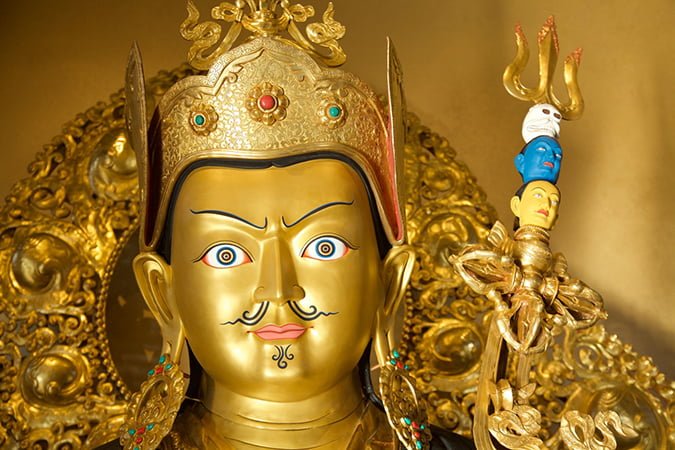
Renunciation and Spiritual Quest
As he grew, Padmasambhava was married to Princess Mandarava and was poised to inherit the throne, along with the wish-fulfilling gem. However, understanding the transient nature of worldly pleasures and life itself, Padmasambhava chose the path of spiritual pursuit over kingship. His resolve led him into exile, allowing him to adopt the life of a yogi.
Dedicated to deep spiritual practice, Guru Padmasambhava engaged in intense meditation across India’s eight great charnel grounds. In these places of death and impermanence, he undertook profound practices, receiving teachings and empowerments from dakinis and mastering the arts of transformation and healing. His journey through these sacred sites culminated in his attainment of siddhis (spiritual powers), earning him the name Dorje Trollo (Wrathful Vajra) for his ability to subdue negative forces.
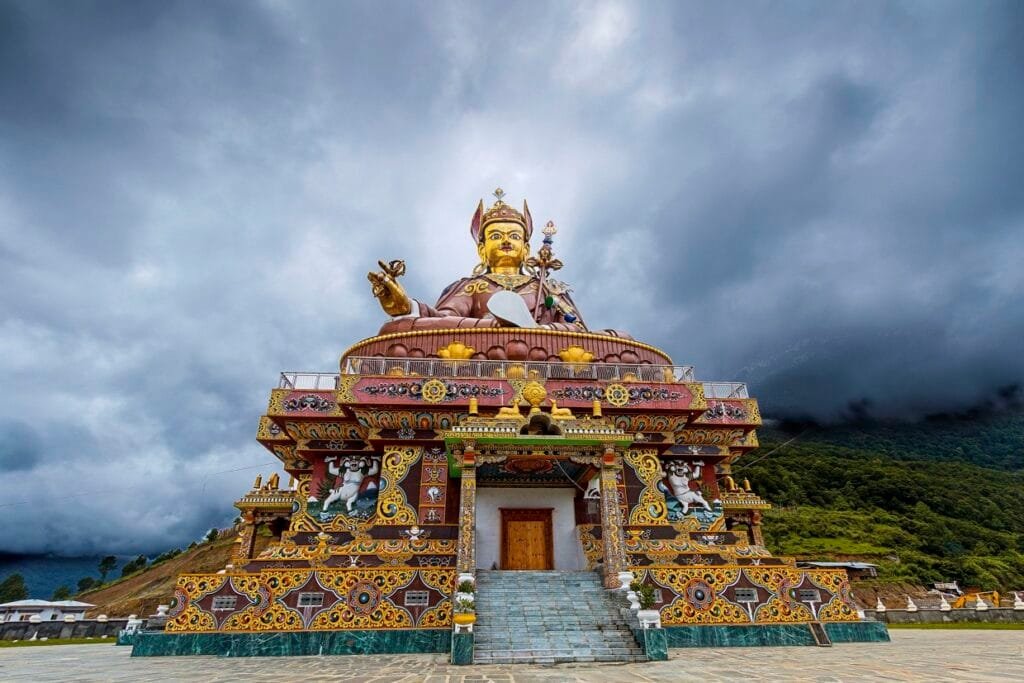
Mastery of Arts and Sciences
Guru Padmasambhava’s quest for knowledge and spiritual mastery also led him to learn various languages, arts, and sciences from wise sages, further enriching his contributions to the spiritual and cultural heritage of the regions he touched. His deep understanding of Sanskrit, astronomy, and other disciplines, along with his skills in sculpture and craftsmanship, underscored his role as a renaissance figure in the spiritual world.
These legends surrounding Guru Padmasambhava illustrate his extraordinary life, marked by divine birth, compassion, renunciation, and profound spiritual achievements. His teachings and legacy continue to inspire and guide practitioners of Tibetan Buddhism to this day.
The Refuge of Guru Rinpoche
1. The Wrathful Guru Padmasambhava
The Wrathful Guru Padmasambhava, known in Tibetan as “Guru Drakpo,” embodies the fierce aspect of Guru Rinpoche unified with Vajrakilaya, the deity associated with the phurba (ritual dagger). This form represents the union of the wrathful guru with the diamond dagger, a protector and subjugator of evil forces, and belongs to the father tantra of the highest yoga tantra class.
The Wrathful Guru Padmasambhava is depicted with a fiery red body, symbolizing the end-of-times fire, with a wide-open mouth and sharp fangs. His tongue, resembling the sound of a thousand thunders, carries the consonants of the throat chakra and the vowels of the navel chakra. With three fiery eyes and eyebrows like blazing flames, he wields a nine-pronged vajra in his right hand and holds an iron scorpion in his left, threatening all malice.
Adorned with a garland of freshly severed heads and wearing a crown of five skulls, his attire includes an elephant skin, human skin, tiger skin, and a necklace of black snakes. His back features two wings of vajra, and his lower body merges into a phurba with a crocodile mouth, piercing the heart of demons. Practicing this deity’s tantra perfects all Buddhist practices, subdues dragons, spirits, demons, and eliminates the three poisons of greed, hatred, and ignorance, swiftly achieving enlightenment for the benefit of all beings.
Mantra: Om Ah Hung Benza Guru Pema Siddhi Hung
2. Prayer to Guru Padmasambhava
The Seven-Line Prayer to Guru Rinpoche:
Hung On the northwest border of the country of Uddiyana, In the pollen heart of a lotus, Marvelous in the perfection of your attainment, You are known as the Lotus-born, Surrounded by many hosts of dakinis. Following in your footsteps, I pray to you: Come and bless me with your grace! Guru Pema Siddhi Hung
This prayer encapsulates the essence of Guru Rinpoche’s miraculous birth, his enlightened activities, and his role as a master and guide for practitioners. It is a call for blessings, guidance, and spiritual protection from the beloved Guru Padmasambhava, revered across the Himalayan regions and wherever Tibetan Buddhism is practiced.
3. The Refuge Field of Guru Rinpoche
The “Refuge Field” encompasses the lineage of past masters, Buddhas of the three times, Bodhisattvas, personal deities, the Sangha, scriptures, dakinis, and protectors within a single image. It unites all supreme virtues and the profound and vast blessings into one field, serving as the “ultimate refuge” for all who take refuge and is considered the most sublime field of merit.
The Refuge Field of Guru Rinpoche
This is the Great Perfection (Dzogchen) refuge field of the Nyingma tradition (Red Sect) of Tibetan Buddhism. At the center is Guru Rinpoche (Padmasambhava), embracing his consort Yeshe Tsogyal on a lotus throne. Directly above in the center are the Great Perfection masters embodying the three lineages: Dharmakaya Samantabhadra, Sambhogakaya Vajrasattva, Nirmanakaya Samantabhadra (Garab Dorje), Manjushrimitra, Sri Singha, Jnanasutra, Vimalamitra, Uddiyana Padmasambhava, King Trisong Detsen, translator Vairotsana, dakini Yeshe Tsogyal, Longchenpa, and Rigdzin Jigme Lingpa; to the upper left and right are lineages of Nyingma masters; beside Guru Rinpoche are the eight great Bodhisattvas and eight great Sravakas; below are Buddhas of the three times, heroes, dakinis, and protectors.
Practitioners are encouraged to visualize this assembly of deities at all times, maintaining mindfulness and awareness. When walking, visualize them in the space to your right shoulder as objects of circumambulation; while sitting, above your head as objects of prayer; during meals, at your throat as recipients of offerings; and while sleeping, within your heart as a method to transform confusion (dreams) into the luminous state. Thus, in all actions, the luminous presence of the refuge field should never be departed from, with unwavering faith and sincere reliance on the Three Jewels, diligently practicing refuge.

4. The Copper-Colored Mountain Pure Land of Guru Rinpoche
The Copper-Colored Mountain is the pure land manifested by Guru Rinpoche’s rainbow body, an infinite world of light, bliss, and wisdom. Located in the center of the continent of Chamara, shaped like a heart and composed of countless precious treasures. At its peak is the extraordinary Lotus Light Palace, a splendid and inconceivable abode of Guru Rinpoche. The palace’s ground floor represents the nirmanakaya pure land centered around Guru Rinpoche, the second floor is the sambhogakaya pure land akin to Mount Potala, and the topmost level is the dharmakaya pure land, akin to the Pure Land of Sukhavati (Dewachen).
5. The Heart Mantra, Mudra, and Seed Syllable of Guru Padmasambhava
Guru Padmasambhava’s Heart Mantra
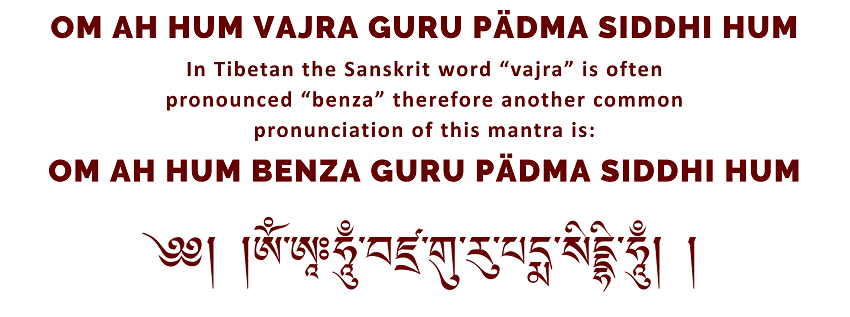
Guru Padmasambhava’s Mudra: (Vajra Mudra of Guru Padmasambhava)
To form the mudra, cross your hands with palms facing your chest, hook the little fingers together, extend the index fingers diagonally upwards, and press each thumb against the second and third fingers to form circles, resembling a vajra.
Seed Syllable:
The red syllable “HRI,” radiating pink light.
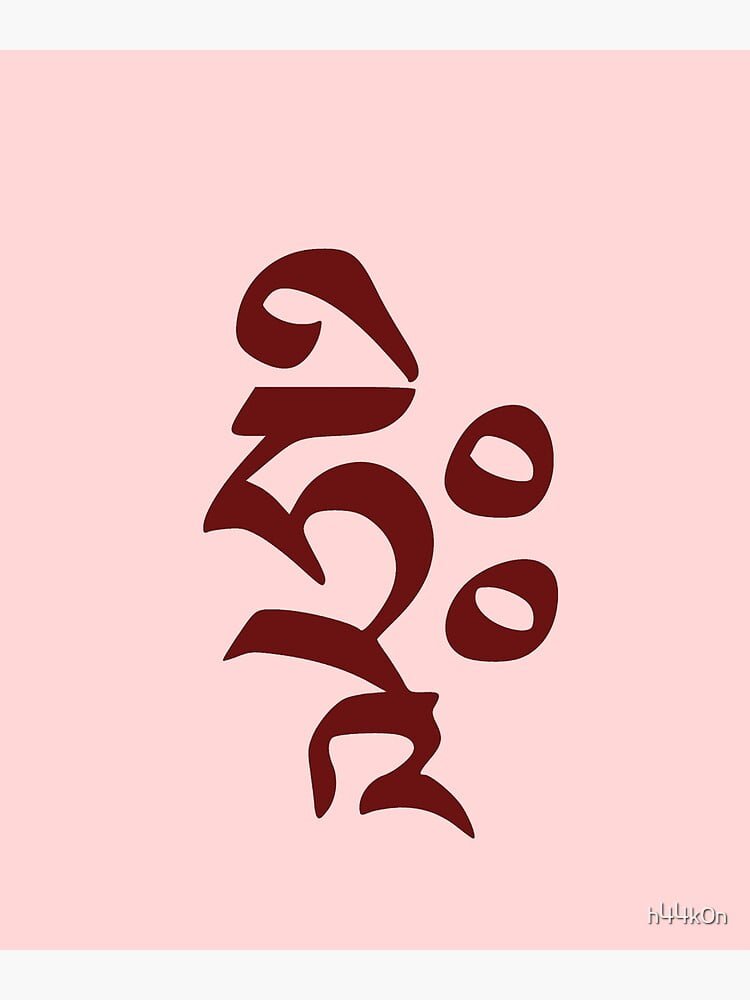
6. The Status of Guru Padmasambhava in Buddhism
People regard Guru Padmasambhava as one of the greatest siddhas in the history of Indian Buddhism, famous for his miraculous powers. King Trisong Detsen invited him, and he traveled to Tibet to spread Buddhism and subdue hostile forces, playing a key role in converting Tibetans to orthodox Buddhism. He skillfully integrated certain aspects of the pre-existing Tibetan religious practices with Indian Buddhism, making a significant contribution to the establishment of Tibetan Buddhism. He also has the attribution for constructing Samye Monastery, the first Buddhist monastery in Tibet.
Following the persecution of Buddhism by Langdarma, the Nyingma school, adhering to traditional practices, venerates Guru Padmasambhava as the foundational guru. The mantras and termas (hidden treasures) he taught hold a central place in Nyingma teachings. Considered an emanation of Amitabha Buddha, Avalokiteshvara, and Shakyamuni Buddha, he embodies their enlightened body, speech, and mind. The Nyingma tradition wraps Guru Padmasambhava in mystique, revering him as a supreme being in Tibetan Buddhism, often calling him the “Second Buddha of Uddiyana” by Tibetans.
7. Overview of Guru Padmasambhava’s Works
Guru Padmasambhava made vast contributions to Buddhist literature, including eight of his works in the Kangyur and Tengyur collections. He significantly contributed to translating numerous esoteric texts for the Nyingma school of Tibetan Buddhism. Tertöns (treasure revealers) discovered many texts in caves and rock formations, purportedly authored by him, which are primarily taught within this tradition but have not been incorporated into the Tibetan Buddhist Canon.
